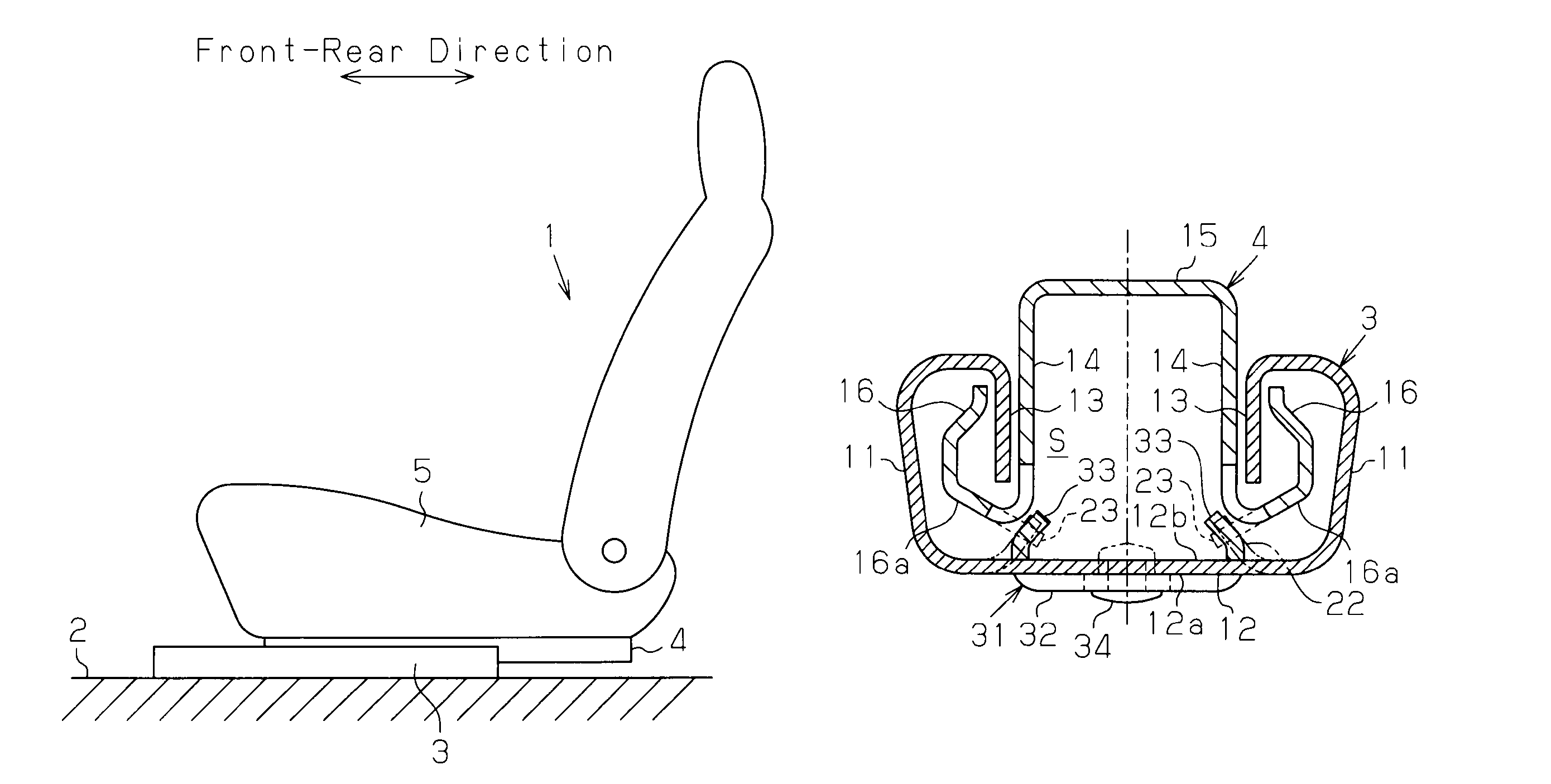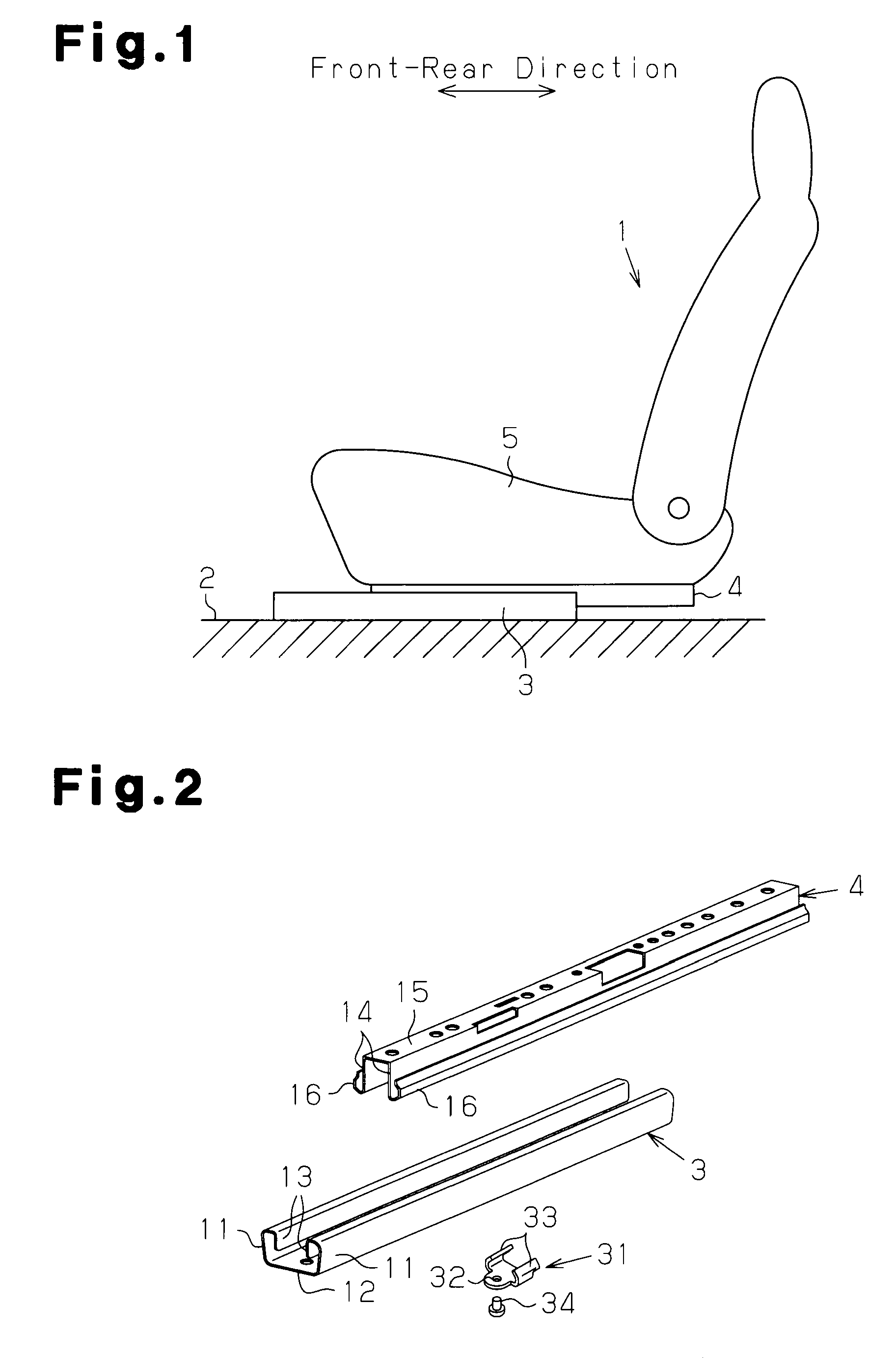Vehicle seat slide device
a technology for lowering devices and vehicles, which is applied in the direction of machine supports, movable seats, roofs, etc., can solve the problems of troublesome installment of stopper brackets, limited movement range of upper rail relative to lower rails, etc., and achieve the reduction of the required strength of the movement limiting portion (the first stopper) and the simplified structure of the movement limiting portion
- Summary
- Abstract
- Description
- Claims
- Application Information
AI Technical Summary
Benefits of technology
Problems solved by technology
Method used
Image
Examples
first embodiment
[0043]the present invention will now be described with reference to the drawings.
[0044]FIG. 1 schematically shows a vehicle seat 1, which is mounted, for example, on a vehicle, and a seat slide device, which slidably supports the seat 1 on a vehicle floor 2. The seat slide device includes a pair of lower rails 3 (only one of them is illustrated) and a pair of upper rails 4 (only one of them is illustrated). The lower rails 3 are fixed to the vehicle floor 2 and extend along the front-rear direction of the vehicle, and the upper rails 4 are fixed to a seat portion 5 of the vehicle seat 1. The upper rails 4 are movably assembled to the lower rails 3.
[0045]The lower rails 3 are arranged in parallel to each other and spaced at a predetermined interval along the widthwise direction of the vehicle seat 1 (the direction perpendicular to the elevation of FIG. 1). Likewise, the upper rails 4 are arranged in parallel to each other and spaced at a predetermined interval along the widthwise dir...
third embodiment
[0087]In the present embodiment, a stopper 71 shown in FIG. 12 is employed as a first stopper. The stopper 71 of the present embodiment is formed by providing the stopper 51 of the third embodiment with a pair of extended pieces 52b, 52c. That is, as shown in FIG. 12, an attachment portion 52 of the stopper 71 includes a flat plate-like coupling piece 52a and the first and second extended pieces 52b, 52c. The first and second extended pieces 52b, 52c are extended beyond the flanges 53 from the front end and the rear end of the coupling piece 52a in a direction of relative movement of the rails 3, 4. The extended pieces 52b, 52c contact the outer surface 12a of the bottom wall portion 12.
[0088]As shown in FIG. 13, the attachment portion 52 is fastened (fixed) to the bottom wall portion 12 of the lower rail 3 by a rivet 54, which serves as fastening means (a fastening member), at the coupling piece 52a, which is a portion between the extended pieces 52b, 52c. Through hole for receivin...
fourth embodiment
[0093]In the present embodiment, a stopper 81 shown in FIG. 14 is employed as a first stopper. The stopper 81 of the present embodiment is different from the stopper 71 of the fourth embodiment in the following points. That is, the attachment portion 52 is fastened (fixed) to the bottom wall portion 12 of the lower rail 3 by rivets 54, which functions as fastening means (a fastening member), at the first and second extended pieces 52b, 52c. Through holes for receiving the rivets 54 are formed in the extended pieces 52b, 52c and the bottom wall portion 12.
[0094]The attachment portion 52 is fitted to the bottom wall portion 12 by a projection / recess fitting structure at the coupling piece 52a, which is a part between the extended pieces 52b, 52c. The projection / recess fitting structure includes a recess 82 formed in the outer surface 12a of the bottom wall portion 12 and a projection 83 formed on the coupling piece 52a to be fitted in the recess 82. As in the fourth embodiment, the pr...
PUM
 Login to View More
Login to View More Abstract
Description
Claims
Application Information
 Login to View More
Login to View More - R&D
- Intellectual Property
- Life Sciences
- Materials
- Tech Scout
- Unparalleled Data Quality
- Higher Quality Content
- 60% Fewer Hallucinations
Browse by: Latest US Patents, China's latest patents, Technical Efficacy Thesaurus, Application Domain, Technology Topic, Popular Technical Reports.
© 2025 PatSnap. All rights reserved.Legal|Privacy policy|Modern Slavery Act Transparency Statement|Sitemap|About US| Contact US: help@patsnap.com



